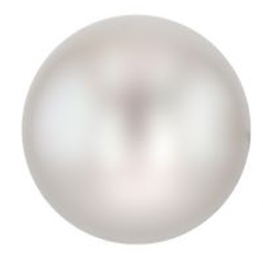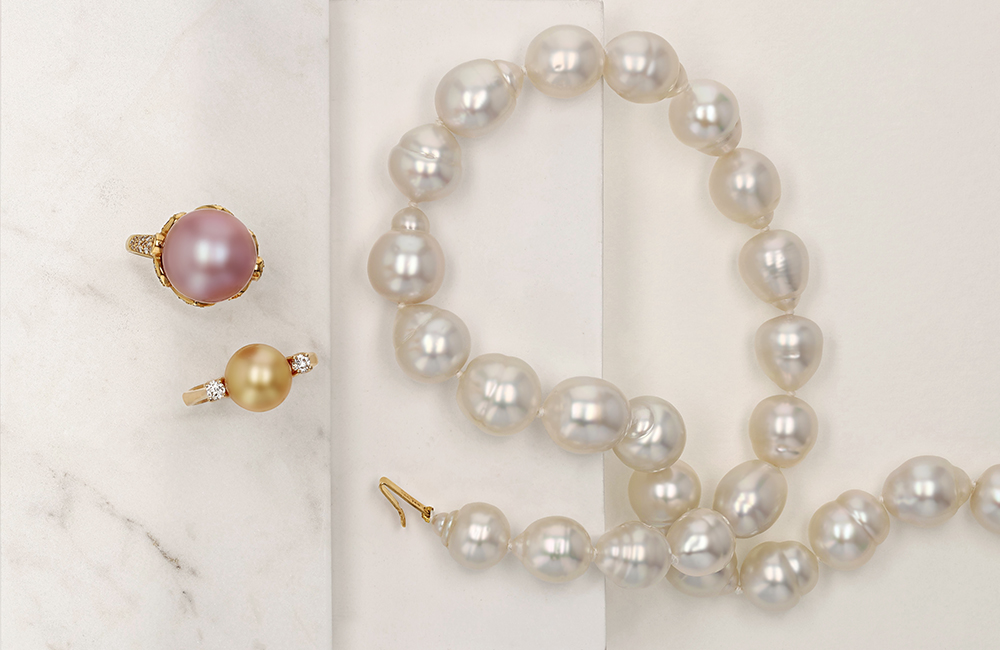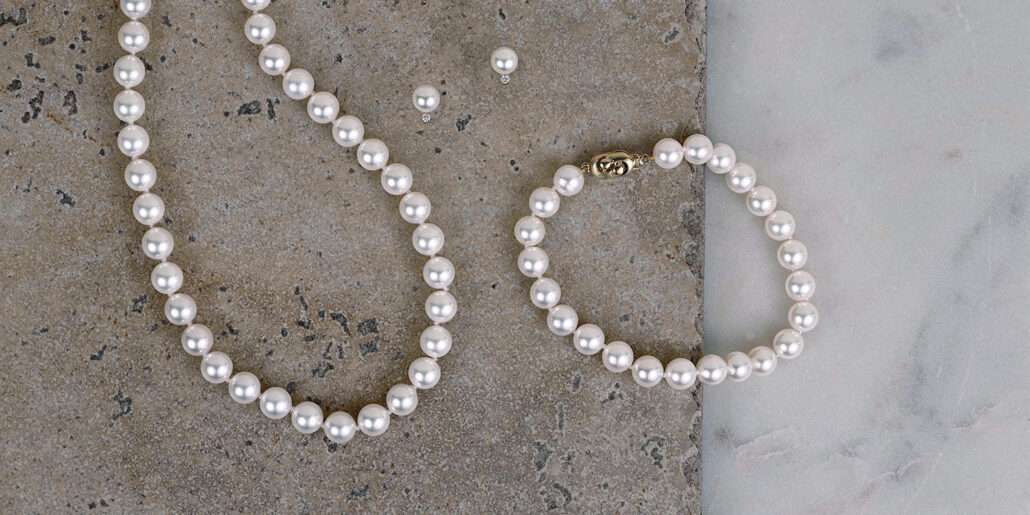Pearl: June Birthstone Quick Facts
Pearl Color: Available in various colors with white being the most common
Pearl Mohs Hardness Scale Rating: 2.5
Pearl Symbolism & Meaning: Purity, elegance and wealth
Pearl Zodiac Signs: Gemini and Cancer
Other Recognitions: Gift for the 30th wedding anniversary.

What is a Pearl?
Pearls are produced within the soft tissue of a living shelled mollusk. Just like the shell of a mollusk, a pearl is composed of calcium carbonate in minute crystalline form, which has been deposited in concentric layers. Pearls are often perfectly round and smooth, but many other shapes, known as baroque pearls, can occur.
Pearls have been highly regarded throughout history, and in many cultures, they symbolize purity, elegance and wealth. Pearls can occur naturally or can be cultured by inserting a foreign object, often a small bead or piece of tissue, into a mollusk. The mollusk then secretes layers of aragonite and conchiolin, which make up its shell, resulting in a pearl.
Pearl Value
The value of a pearl can vary significantly based on several factors. Whether the pearl is natural or cultured will impact its overall value most. Natural pearls form without any human intervention and are found in the wild. They are extremely rare and thus very valuable. Cultured pearls are created with human intervention, where a bead or a piece of tissue is inserted into the mollusk to stimulate the pearl-forming process. Cultured pearls are more common than natural pearls and are generally much less expensive.
Other factors that influence a pearls value include:
- Size: Larger pearls are rarer and generally more valuable. Pearl size is measured in millimeters.
- Shape: Perfectly round pearls are the most valuable due to their rarity. However, pearls come in various shapes, such as oval, drop and baroque. Baroque pearls, which are irregularly shaped, are usually less expensive.
- Color: Pearls come in a range of colors, including white, cream, pink, silver, gold and black. The most valuable and classic pearls are white with a rose overtone. Unusual colors, like black pearls from Tahiti, can also be valuable.
- Luster: Luster refers to the shine or glow on the surface of the pearl. Pearls with a bright, reflective luster are more valuable than those with a dull or chalky appearance.
- Surface Quality: Pearls with fewer blemishes, spots or irregularities on their surface are more valuable. Perfectly smooth pearls are rare and highly prized.
- Origin: Pearls from certain regions, such as the Persian Gulf, are highly valued due to their historical significance and rarity.
- Type of Mollusk: Different mollusk species produce pearls, and the type of mollusk can influence the pearl’s value. For example, Akoya pearls are produced by the Akoya oyster and are known for their round shape and high luster.
- Cultivation Period: The longer a pearl is left to develop in the mollusk, the thicker the nacre (layers of calcium carbonate) becomes, resulting in a more valuable pearl.
- Market Demand: Like everything, trends and market demand also influence the value of pearls. Fashion trends and cultural preferences can affect the desirability and overall value of certain pearls.
It’s important to have pearls appraised by a reputable jeweler or gemologist to determine their exact value, especially for high-value or antique pieces. Certification, provenance and historical significance can also play a role in determining the value of pearls.

Pearl Care & Cleaning
Did you know that not wearing your pearl jewelry is doing more harm than good? A pearls’ luster only improves when worn next to the skin as the oils of the wearer keep them moisturized. If not exposed to moisture every so often, your pearls will dry out and fracture, rendering them unwearable and likely beyond repair. You can even lay them out while you shower so they can absorb the humidity of the environment. Proper storage is also a must. Do so by resting your pearls in a slightly damp cloth—never in a hanging position because it can stretch and damage the silk. Always store your pearl jewelry separately from other pieces to minimize accidental contact or scratches. Plan on restringing your pearl strand necklaces every 3 to 5 years as the silk that holds the pearls together will likely get dirty and cannot be restored to its original state.
Other essentials to bear in mind are to
- keep your pearls far from sources of heat or cold, like fireplaces or open windows,
- avoid doing household or outdoor chores while wearing your pearls, and
- as always, apply all cosmetics before you put on any gemstone jewelry, but be particularly cautious with your pearl jewelry because it reacts very poorly to acids and alcohols.
Though it may seem harmless, refrain from wiping dirt off your pearl jewelry. This seemingly innocent action can inadvertently scratch the surface of the stone(s). For reference, most household dust is a 7 to 7.5 on the Mohs Hardness Scale and pearls fall at a level 2.5 on that scale, making them very susceptible to scratching and damage from harder materials and gemstones.
To witness the best results, we recommend that you bring your pearl jewelry in for professional cleaning and inspection at least twice a year.
Pearl Jewelry & Gift Ideas
Whether you are shopping for yourself or someone else, Borsheims has an extensive selection of pearl jewelry in various styles. If you need help picking out the perfect piece of pearl jewelry, one of our experts would be happy to assist you. Stop into our store or text or call 402.391.0400 during store hours to speak with one of our friendly and knowledgeable sales associates.

